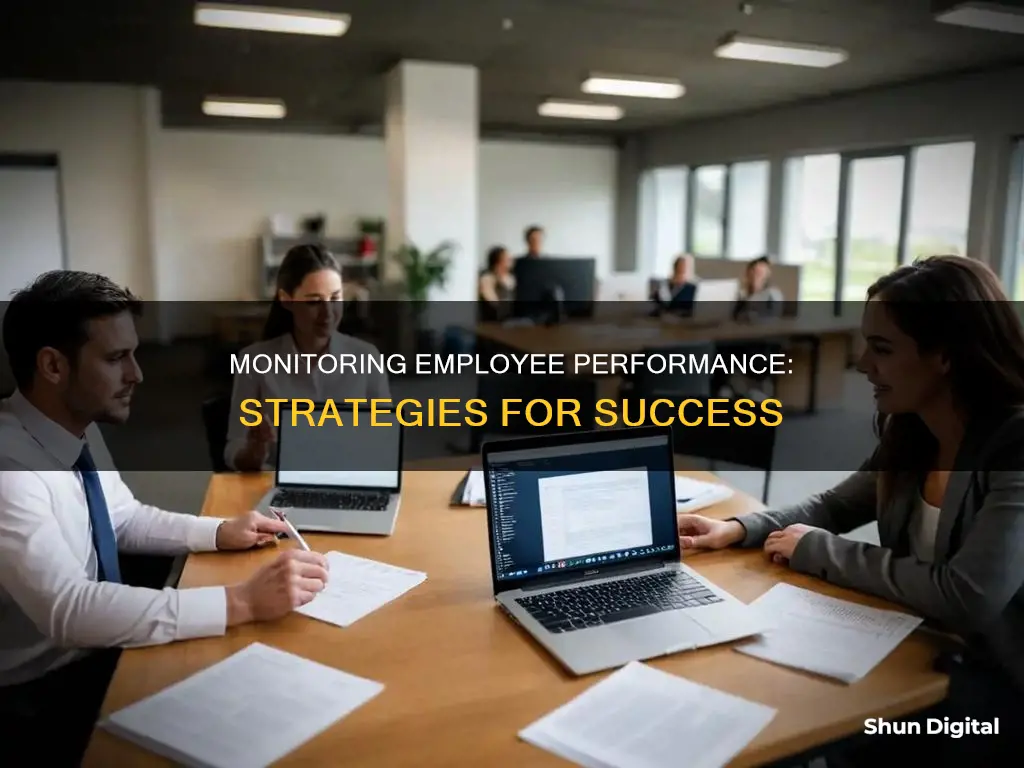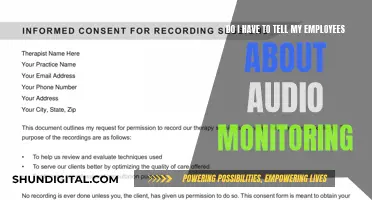
Monitoring employee performance is an important aspect of staying competitive and driving business success. It involves conducting periodic checks to evaluate an employee's performance against established standards, and can take several forms, such as reviewing work, observing employee activities, analysing reports and data, and gathering feedback. Effective monitoring helps organisations manage operations, understand employee engagement, and improve performance through training and development. While monitoring can have benefits, it is important to respect employee privacy and be mindful of the potential negative impacts on trust, job satisfaction, and stress levels.
| Characteristics | Values |
|---|---|
| Frequency of monitoring | Should be proposed by the employee, but new tasks or jobs require more frequent monitoring |
| Nature of monitoring | Should be proposed by the employee, but supervisors should communicate the purpose and intended frequency of monitoring |
| Type of work | Visual monitoring is more effective for in-person work, while task management software is better for remote teams |
| Employee involvement | Employees should be involved in the evaluation of their performance to create an approachable and safe environment |
| Performance evaluation | Monitoring provides data for performance evaluation and allows supervisors to reinforce good performance and address poor performance |
| Performance standards | Monitoring is done in relation to established performance standards |
| Performance tracking | Performance tracker software can be used to collect data on employee performance |
| Performance measurement | Quality, efficiency, and quantity of work produced are key performance measures |
| Employee wellbeing | Prioritising employee wellbeing can drive successful, engaged, and motivated employee performance |
| Employee recognition | Rewards and recognition schemes can motivate employees and recognise their hard work |
What You'll Learn

Regular one-on-one meetings
Structure and Frequency
The ideal frequency for one-on-one meetings is weekly for 30 minutes. However, this may vary depending on the manager-employee relationship and the specific needs of the team. If it's a new relationship, it's better to overbook and adjust as needed. Consistency is key, and meetings should be scheduled at regular intervals to build trust and maintain open communication.
Setting an Agenda
Before the meeting, set a clear agenda and share it with the employee. This allows both parties to prepare and ensures the discussion stays focused and productive. While the agenda should be collaborative, it's important to give employees ownership of the agenda to encourage them to take charge of the conversation.
Creating a Safe Space
One-on-one meetings should be a safe and confidential space for employees to express their ideas, concerns, and feedback. As a manager, it's important to actively listen, engage in dialogue, and pay attention to the employee's tone and body language. Creating a psychologically safe environment will encourage open and honest communication.
Topics to Cover
The meetings should go beyond mere status updates and cover a range of topics, including:
- Well-being and personal development: Check in on the employee's well-being, workload, and personal development goals.
- Priorities and progress: Discuss pressing issues, individual goals, and progress made since the last meeting.
- Team contribution: Help employees understand how their efforts contribute to the team's goals and the organization's mission.
- Action items and next steps: Identify action items and agree on commitments to be achieved before the next meeting.
Best Practices
- Start with a well-being check-in: Ask open-ended questions about the employee's mental and physical health, workload, and personal development.
- Keep it confidential: Respect the privacy of the employee and avoid identifying individual responses to feedback.
- Be mindful of your body language: Ensure you maintain eye contact and exhibit an open and attentive posture to make the employee feel heard.
- Avoid distractions: Minimize interruptions and put away your phone and laptop to show that you're fully present and engaged.
- Seek feedback: Encourage two-way feedback by asking for the employee's input and suggestions for improvement.
By implementing these practices, managers can effectively utilize one-on-one meetings to monitor employee performance, address concerns, and foster a positive and productive work environment.
Monitoring Comcast Data Usage: Tips and Tricks
You may want to see also

Performance management software
Features of Performance Management Software:
- User-Friendly Interface: An intuitive and easy-to-navigate interface ensures that managers and employees can easily access and utilise the platform, improving efficiency.
- Goal Setting and Tracking: This feature facilitates the setting and monitoring of personal and professional objectives, ensuring clear communication and alignment between employees and managers.
- 360-Degree Feedback: Performance management software enables feedback from peers, subordinates, and supervisors, providing a holistic view of an employee's performance and fostering a fair evaluation process.
- Real-Time Feedback: Real-time feedback allows for immediate recognition and constructive criticism, helping employees adjust their performance and promoting a culture of continuous improvement.
- Performance Review Automation: The software streamlines the scheduling and execution of performance reviews, ensuring consistency and timeliness.
- Customisable Review Templates: Flexible and customisable review forms allow organisations to adapt the evaluation process to their specific needs and criteria.
- Analytics and Reporting: Performance management software provides data-driven insights into performance trends and areas for improvement, aiding managers in making informed decisions.
- Integration Capabilities: Seamless integration with other HR systems and productivity tools ensures a cohesive ecosystem, improving data flow and reducing disruptions.
- Security and Privacy: Performance management software prioritises data privacy and security, employing encryption and compliance with international standards to protect sensitive employee information.
- Mobile Accessibility: Mobile access allows employees and managers to engage with the platform on the go, facilitating continuous communication and feedback.
Advantages of Performance Management Software:
- Enhanced Goal Alignment: Performance management software ensures that individual objectives are aligned with organisational goals, improving overall productivity and focus.
- Continuous Feedback Loop: Real-time feedback and communication facilitate a culture of continuous improvement, increasing employee engagement and satisfaction.
- Increased Employee Engagement: Recognition and feedback motivate employees, boosting morale and retention rates.
- Data-Driven Decisions: Analytics and insights from performance data assist in making informed decisions regarding promotions, training needs, and succession planning.
- Streamlined Evaluation Process: Automation of performance reviews reduces the administrative burden on HR departments, allowing them to focus on strategic initiatives.
Monitoring Server Performance: JMeter's Essential Role
You may want to see also

Self-monitoring tools
Monitoring employee performance is an important aspect of staying competitive. It helps uncover areas where employees and processes can improve and also plays a major role in driving business success.
Project Plans
Project plans are a type of self-monitoring tool that helps employees organize and track their work. They can be used to set goals, create timelines, and manage resources. Project plans can also help employees stay focused and motivated by providing a clear roadmap to follow.
Checklists
Checklists are a simple but effective self-monitoring tool. They can be used to ensure that employees are completing tasks correctly and consistently. Checklists can also help employees stay organized and efficient by providing a clear list of tasks to be completed.
Activity Logs
Activity logs are like diaries that employees keep throughout the day. They note down their activities, including breaks and interruptions, and the time spent on each task. This helps employees track their time and identify areas where they may be losing focus or facing challenges.
Graphs and Charts
Graphs and charts are visual self-monitoring tools that can be used to track the frequency and duration of certain activities. They can be accompanied by written instructions, pictures, and videos to help employees understand their progress and identify areas for improvement.
Self-Monitoring Checklists
These are similar to regular checklists but are more detailed and specific. Self-monitoring checklists can include questions that help employees reflect on their performance and identify areas for improvement. For example, "Did I meet my goals for today?" or "Are there any obstacles I'm facing that I need to address?"
By using these self-monitoring tools, employees can take ownership of their work and progress. It also helps managers by providing them with data and insights without micromanaging, fostering a more positive and productive work environment.
The Ankle Monitor: XXXTentacion's Troubled History
You may want to see also

Peer reviews and 360-degree feedback
Monitoring employee performance is an important aspect of maintaining a competitive edge for businesses. It helps identify areas of improvement for both employees and processes, and also plays a significant role in driving business success. One effective way to monitor employee performance is by integrating peer reviews and 360-degree feedback. This method provides valuable insights from multiple perspectives and gives a holistic view of an employee's performance.
The benefit of this approach is that it offers a comprehensive view of an employee's performance by gathering insights from multiple sources. It helps managers understand how others perceive their strengths and weaknesses, promoting self-awareness, accountability, and ownership among employees. Additionally, it provides an opportunity for employees to develop their leadership skills and improve their overall job performance.
However, one challenge with 360-degree feedback, specifically peer appraisal, is that it can be time-consuming and politically charged, sometimes exacerbating bureaucracy within the organisation. Nevertheless, when done properly and consistently, 360-degree feedback can be an incredibly valuable tool for employee development and performance appraisal.
To maximise the effectiveness of 360-degree feedback, it is recommended to conduct these evaluations every one to two years, allowing employees sufficient time to work on their development plans. Additionally, it is crucial to ensure employees understand the benefits of the process and to maintain consistency in conducting the reviews. Providing post-review support and creating action plans together with employees can further enhance the impact of the feedback.
In conclusion, peer reviews and 360-degree feedback are valuable components of employee performance monitoring. They provide a holistic view of employee performance, promote self-awareness, and help develop leadership skills. When used effectively and consistently, these tools can drive employee growth and improve overall business performance.
Starting a Business: Security Monitoring a Priority, Not an Afterthought
You may want to see also

Employee wellbeing
Impact of Monitoring on Employee Wellbeing
The use of employee monitoring software has sparked debates about its effects on workplace wellbeing. While some organizations view it as a solution for flexible working and remote teams, others argue that it can negatively impact trust, morale, and workplace relationships. Monitoring software may give employees the impression that their managers don't trust them to complete tasks without supervision, potentially hindering open communication and collaboration.
Harvard Business Review's survey of 200+ US workers revealed that being under surveillance can make employees feel "less responsible" and "more likely to act immorally." This indicates that monitoring can trigger the opposite behaviour of what it intends to prevent, leading to increased rule-breaking and discreet work breaks.
Strategies for Monitoring Employee Performance While Promoting Wellbeing
- Regular Check-Ins and One-on-One Meetings: Instead of solely relying on monitoring software, encourage team leaders to have frequent, casual check-ins and one-on-one meetings with employees. These meetings help maintain transparency, address concerns, and foster a positive working relationship between managers and employees.
- Performance Management Software: Utilise performance management software to streamline the performance monitoring process and free up time for managers and HR professionals. Choose software that automates routine tasks, helps set goals, track progress, and monitor employee performance with data-backed decisions.
- Employee Monitoring Software with Privacy: If using employee monitoring software, prioritise platforms that maintain employee privacy while providing insights into performance. Ensure the software helps identify roadblocks and provides tools to address productivity issues, rather than solely focusing on surveillance.
- 360-Degree Feedback: Incorporate peer reviews and 360-degree feedback to gain a holistic view of an employee's strengths and areas for improvement. This method involves gathering confidential evaluations from colleagues, subordinates, and managers, promoting a culture of open communication and feedback.
- Self-Reported Surveys: Distribute self-reported surveys to understand how employees perceive their performance and engagement. However, be mindful that employees may censor themselves or lack objective data to base their responses on. Professionally script and carefully word the surveys to encourage honest and meaningful feedback.
- Incentives for Participation: Offer incentives such as raises, promotions, or bonuses to encourage employee participation in performance monitoring programs. Emphasise that monitoring will help employees track their progress, identify areas for improvement, and work towards achieving their goals.
- Observation and Casual Conversations: Use your own observations and casual conversations with employees to gauge their performance and wellbeing. Engage with employees in casual settings, pay attention to their attitudes, and be attentive to their interactions during conference calls or messaging channels.
By combining these strategies with a compassionate and personalised approach to employee wellbeing, organisations can optimise performance while fostering a positive and supportive work environment.
Monitoring Internet Usage: Free LAN Solutions
You may want to see also
Frequently asked questions
Monitoring employee performance is a way for organisations to manage their operations and understand employee engagement. It involves conducting periodic checks to determine an employee's performance in relation to established standards.
Monitoring employee performance helps organisations understand if employees are meeting, exceeding, or falling short of benchmarks. It also helps develop training programs, implement rewards and recognition schemes, motivate employees, and address employee wellbeing.
There are several methods to monitor employee performance, including regular check-ins and one-on-one meetings, using performance management software, observing employees directly, and utilising self-reported surveys and peer reviews.
It is important to respect employee privacy and be transparent about the monitoring process. Involving employees in the evaluation process and focusing on improvement, rather than punishment, can also help build trust and a positive work environment.







